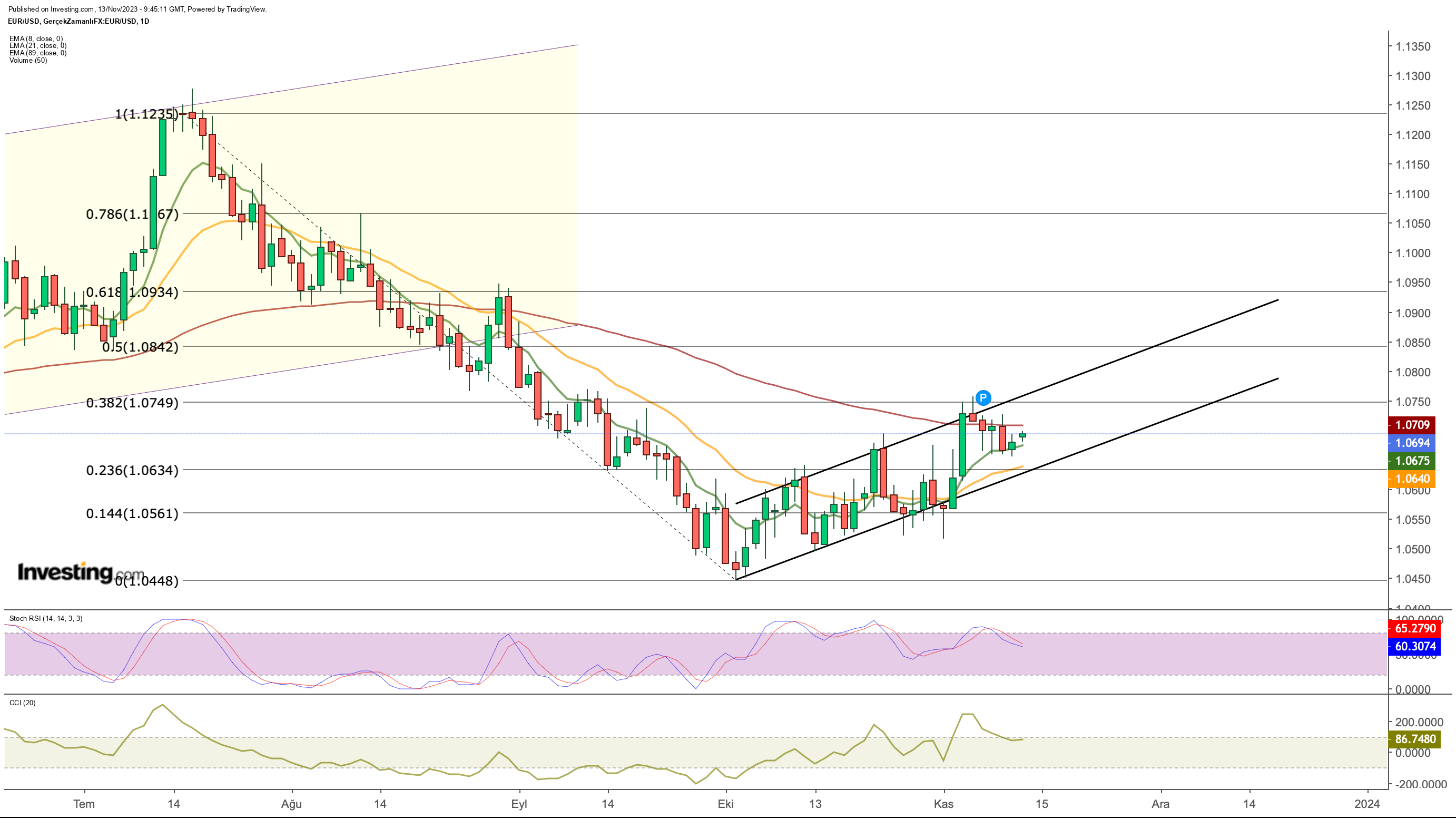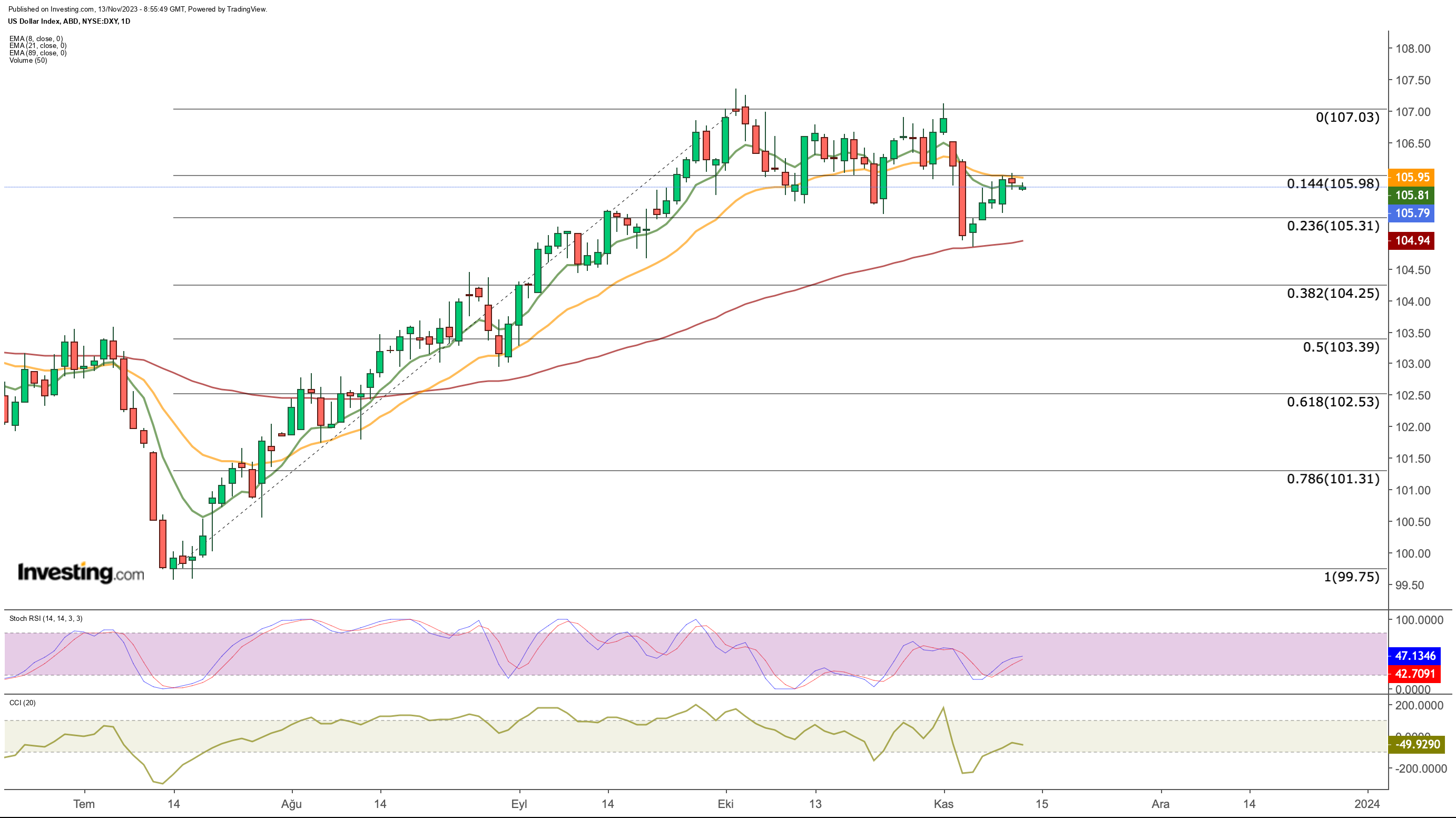- US dollar stalls at the 106 resistance as investors turn focus to key inflation data
- EUR/USD pulls back from $1.073, eyeing support at $1.067
- Meanwhile, Moody’s downgrades the US credit rating outlook, prompting a rise in long-term bonds
- Secure your Black Friday gains with InvestingPro’s up to 55% discount!
Despite the somewhat dovish stance of Fed members causing a surge in risk assets last week, the also experienced a partial uptick, reaching a peak near 106. After facing resistance at this level, the greenback stalled as investors switched to a cautious stance ahead of the upcoming data release.
Post market closure on Friday, international credit rating agency Moody’s downgraded the country’s credit rating outlook from stable to negative, citing heightened downside risks to US fiscal strength, which resulted in a partial rise in long-term US bonds. Moody’s predicts that the US fiscal deficit will persist at elevated levels, and debt solvency could weaken significantly without effective fiscal policy measures to reduce government spending and boost revenue, especially with prevailing high-interest rates.
In spite of these developments, inflation remains a focal point for the market. The Fed continues to caution that any deterioration in the downward trend in inflation and robust growth data might prompt a return to interest rate hikes. The juxtaposition of financial strain due to high financing costs and the Fed’s resolute stance against inflation underscores the critical importance of the forthcoming inflation data.
Tomorrow, October’s US inflation data is set ticker lower from 3.7% to 3.3% YoY, while is anticipated to remain steady at 4.1%. Recent US data reveals signs of economic activity weakening in the country, aligning with the expectation of a sustained downward trend in inflation. Consequently, if the Consumer Price Index (CPI) data aligns with or falls below expectations, it may boost risk appetite and alleviate pressure on the Fed.
Conversely, a deviation from expectations could prompt the Fed, currently in a watchful stance, to return to a more hawkish rhetoric, potentially leading to a significant surge in demand for the dollar.
In the light of recent developments, the dollar index remains technically under pressure. The DXY entered a gradual retracement trend after turning the uptrend flat in October, encountering resistance at 107. Since October, the index has continued to find support at 105.3, while the 106 level has been trending to become a new resistance area.
If the US CPI continues to weaken, it will strengthen the view that the Fed may close the year by leaving interest rates unchanged and we may see that the DXY may shift below 105 and set its new support at 104.25 levels in a gradual retreat trend. Anything else would have the effect of weakening risk appetite and may increase demand for the dollar, thus raising the possibility that the dollar index may once again test the 2023 peak of 107.
EUR/USD
The eased slightly from the upper band of the ascending channel formed in the short term last week in the recovery trend that has been continuing since October.

After the bears drove the euro down from the $1.073 level, the pullback seems restricted to $1.0666.
Currently, the EUR/USD chart highlights $1.067 as the nearest support level, indicating potential advances towards the $1.075 resistance as long as it remains above this threshold this week.
Notably, $1.064 stands out as a robust support point in the lower region, and the pair’s closure above this level by week-end supports a moderate appreciation of the Euro against the dollar.
On the flip side, if the Euro decisively breaches the $1.075 resistance, especially under conditions favoring increased risk appetite, the pair may experience a swift ascent towards $1.09.
Key events in the Eurozone this week impacting the EUR/USD parity include the region’s 3rd quarter GDP data and CPI data set for announcement on the week’s final working day.
Beyond these crucial figures, speeches from ECB President and members may influence the euro, shaping the economic outlook in the Eurozone. Investors will closely monitor the ECB’s latest views on interest rate policy, considering the economic contraction.
In summary, the short-term outlook for the EUR/USD pair may pivot on US and Eurozone inflation. If inflation stabilizes due to the more resilient US economy, it could reinforce a more hawkish Fed approach, boosting demand for the dollar, potentially leading to a weakening in the EUR/USD pair.
However, in this data-intensive week, robust figures from the Eurozone and a decisive stance from the ECB may serve as criteria driving the EUR/USD pair upward.
***
Beat the Market with InvestingPro’s Exclusive Black Friday Deal
This Black Friday, don’t miss out on the opportunity to make your investments work harder for you. Subscribe to InvestingPro now with an up to 55% discount and secure your position among the savviest traders in the market.

Claim Your Discount Today
**Disclosure: The author holds no positions in any of the securities mentioned in this report.
Credit: Source link




